| MUSEUM
Antique Rosaries |
HISTORY
of the Rosary |
for you index |
cord instructions |
LINKS |
EMAIL
US+
877 695 3561 |
|
DON BROWN COLLECTION (please note the images on the left do not immediately relate to the text on right (below). They only represent a sampling of the rosaries in the collection.) |
|
Far and to the West and North of our country - almost as far as you can go - is a collection of over 4000 rosaries - the world's largest. Near the small town of Stevenson, Washington overlooking the overwhelming Columbia Gorge - right on the pathway of Lewis and Clark's famous ‘Journey of Discovery', and about 45 minutes East of Portland, Oregon is this wonderful place. DON BROWN COLLECTION - DESCRIPTIONS SENSE OF PRAYER - VARIATIONS IN DESIGN - LENGHTS ABOUT MUSUEM |
|
INTERPRETIVE CENTER This collection, housed in the Columbia Gorge Interpretive Center also called the ScamaniaInterpretive Center, captures the imagination. Regardless of how you come upon this collection - by either turning the corner of the displays in pursuit of regional history or going there just to see the exhibit, it remains with you. The variation is astounding. We were graciously welcomed by Sharon Tiffany and her staff. They graciously allowed us to photograph and study this collection for your information. (this is a big page taking time to load) |
|
~ DESCRIPTIONS ~ Don Brown numbered the Rosaries and wrote a mini history about each one. The Interpretive Center has set all this information into a Computer, which opens each one up for the viewer. Some of particular interest: + (not in proper sequence, just enjoy images and descriptons individually) |
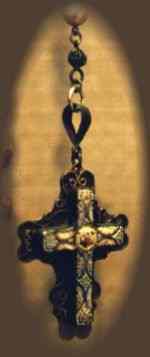 |
A GROWING COLLECTION
This remarkable collection came to Don Brown, who was from the area. He did not travel much but people heard about his collection and sent him rosaries. People like the Kennedy's and people like your next door neighbor. Some have been blessed by Popes, others by local priests and one was blessed by Padre Poi. There is even a relic case containing a rose petal which was on the altar when Padre Pio said his last mass. One was hand chained by Sister Lucia de Santos (Fatima) as a special request of her older sister. Father Flannigan of Boys Town fame sent a rosary of olivewood |
 |
OTHER THAN
CHRISTIAN
This collection also contains rosaries from other than the Christian faith. Counting beads from Native Americans, Mohammedans, Buddhists and other religious groups are there for you to see. According to the brochure, "Before the Christian era the Jews were accustomed to reckon their prayers on beads..." and "It is said that perhaps three quarters of the human race are given to their use." INSPIRED BY THE
SISTERS
|
 |
-------------------------------------
#1 - THE FIRST ROSARY The first rosary of the Don Brown collection is of 15 decades of black cocoa beads and a sterling center connecting medal. Cross is ebony and silver. donor: Benedictine Sisters of Clyde Mo ------------------------------------- #4 - CONTAINS A MINIASTURE ROSARY Is made of ‘Jesuit Nuts' or ‘Trapa Seeds' the Trapa is native to tropical and sub tropical climates, but is also found in central Europe. It is an aquatic plant and is also known as ‘Water Chestnuts'. It is grown for food in China. The cross is also of the Trapa Seed and attached to it is a small nickel case which contains a miniature rosary. Origin: France. ------------------------------------- |
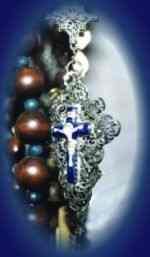 |
------------------------------------- #98 - STAUROLITE PATERS Made by Don Brown of seeds from the Catalpa tree. The Pater beads are of crystals which naturally grow into a cruciform shape or crosses, called Staurolite or ‘Fairy Crosses' found only in Virginia. -------------------------------------- |
|
~ DESCRIPTIONS ~ Don Brown numbered the Rosaries and wrote a mini history about each one. The Interpretive Center has set all this information into a Computer, which opens each one up for the viewer. Some of particular interest: + (not in proper sequence, just enjoy images and descriptons individually) |
 |
--------------------------------------
287 - RUSSIAN SOUVENIR A souvenir from the Orthodox Monastery at Murom (Central Russia). The 10 decades of wooden beads are each covered with worn purple silk. Large wooden spacer beads, are covered with rows of strung seed beads of pale blue and gold, creating an overall design. The wire chain terminates at an elaborate tassel of looped and twisted strands of seed beads. Beads are of light and dark blue. Gift of Mrs. Carl Swanson (WA) -------------------------------------- #422 - PRE HISTORIC WOOD Hand made wooden beads make up this large rosary, formed of trees from a pre-historic submerged forest famous in the legend of the Bridge of the Gods, Columbia River Gorge, near the Center. -------------------------------------- 464 - UPPER BAVARIAN FILIGREE - 1770 A Filigree Brigittine Chaplet from 1770, made of cut glass amber beads which are divided by larger silver filigree beads. Cross: Ebony, no corpus. Above this cross is a smaller filigree cross called a ‘Cross of the Vision' (Also known as the ‘Credo Cross') There are 3 medallions attached to the circle, the largest one bearing a relief of Ben Franklin. Also attached is a tiny acorn relic case. Origin: Upper Bavaria. (Donor: Dom Paul Nolpert OSB of Benedictine Abbey (Ettal) Chapel. Blessed on tomb and touched by relics of St. Walburger through kindness of the nuns of Basilica of St. Walburg. Eichstatt, Upper Bavaria. -------------------------------------- |
 |
--------------------------------------
#511 - FILIGREE OCTAVO CHAPLET - 1730 A filigree rosary called an Octavo Chaplet. It has 8 groups of 8 small black glass beads divided by 9 larger beads strung on black thread or cord. Center: filigree and cross dated 1730, it is the oldest in the collection. Souvenir from an ancient Spanish Cathedral in Manila PI. -------------------------------------- |
 |
-------------------------------------- #701 - BRIGGITTINE CHAPLET - 790 Ancient handmade Brigittine chaplet of filigree elements. 6 decades of crude amber beads with dividers of larger amber on a bronze chain. Large, ornate reliquary cross dated 1790, Origin: Bavaria, gift of Margaret Hanlon (The 63 Ave beads of the Brigittine Rosary represent the 63 years of Mary's life according to tradition. The 7 Pater Beads represent the 7 sorrows and 7 joys of the Blessed Virgin Mary.) --------------------------------------
|

|
------------------------------------- #704 - ROSES ON A CHAIN A beautiful souvenir rosary known as the ‘Rosary of Roses'. Made of tiny handmade red rose blossoms, by the Reverend Sisters of Good Shepherd (Milwaukee, Wi). Used in mission work in 1942. Gift of Mr. Gilbert Morris. ------------------------------------- #723 - CARVED DEER HORN The beads of this rosary are carved from deer horns by Mr. Regis Boileau of St. Germain, Quebec, Canada. ------------------------------------- #1143 - CARVED CORAL BEADS A filigree Rosary with pink coral beads beautifully carved. ------------------------------------- #1324 - MADE BY SISTER LUCIA A 15 decade rosary of crude white bone beads, made by Sister Lucia de Santos, (Fatima) for her older sister Senhora Maria dos Anjos Valinho of Aljustrel, Portugual. Gift of Kevin F McCarthy of Concord NSW Australia, who knew Senhora Valinho. -------------------------------------
|
 |
--------------------------------------
#516 - FROM FATHER FLANNIGAN Small round olive wood beads and cross from Palestine. Gift of Rt. Rev. Msg. E.J. Flannagan of Boys Town, Nebraska. His name is inscribed on the back of the cross. ------------------------------------- #637 - WASHED ASHORE A Jobe's Tears rosary found on the beach in Florida, entwined on a twig washed ashore in a storm. Still on the twig as found by Sister Mary Michelia of Notre Dame College, South Euclid, Ohio. ------------------------------------- #792 - FIRST PAPAL BLESSING The first rosary blessed by Pope Pius XII by a friend of Mr. Browns, Fr. Salvatore Burgio CM of Emmetsburg, MD. who was in Rome in 1939 as a conclavist for Cardinal Dougherty at the Vatican for the election of the Pope. Immediately after he was vested he gave his first blessing of rosaries on request of Fr. Burgio. -------------------------------------
|
|
~ DESCRIPTIONS ~ Don Brown numbered the Rosaries and wrote a mini history about each one. The Interpretive Center has set all this information into a Computer, which opens each one up for the viewer. Some of particular interest: + (not in proper sequence, just enjoy images and descriptons individually) |
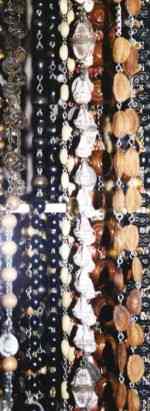 |
--------------------------------------
#1906 - BLESSED BY PADRE PIO This rosary was blessed by the stigmatist, Capuchin Friar, Padre Pio of the Monastery at San Giovanni Redondo, Italy. Gift of Fr. Richard Bauersfeld, OSB of Ettal. The collection also holds a relic case containing a rose petal from the altar of the last Mass said by Padre Pio. ------------------------------------- #1961 - LITANY OF THE BLESSED MOTHER A rosary of black composition beads, each containing a colored portrait of a different Madonna under isinglass. Titles are in Latin on the reverse side. They represent the Litany of the Blessed Virgin Mary. Origin: Rome. ------------------------------------- #2008 - BLESSED BY POPE PIUS XII A rosary given to Rev John O'Neill, Bishop of Grand Falls, NF by Pope Pius XII just 10 days before the death of the Pope. A medal bearing relief's of Pope Pius XII and the Holy Family and blessed by the Pope was attached. It had been given to Rev. Father Malcolm C.P. of Rome Italy, who presented the rosary to Mr. Brown. ------------------------------------- |
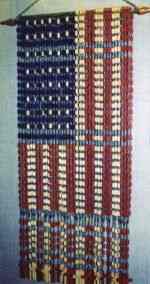 |
-------------------------------------
#2369 - FIGURES IN BEADS Flat oval clear beads contain miniature figures of Mary Immaculate, with plastic heart dividers. Dated 1961, from Lohmanns gift shop, St. Paul Minnesota. ------------------------------------- #2757 - WW I ROSARYFROM BULLETS - 1915 This rosary was sent to him by a young medical student in Yugoslovia. The beads are round lead shot or bullets about the size of a dime. Small brass rifle shells, set crosswise are used as Paters. The centerpiece is a large copper heart engraved "1915" and the cross is made of 3 large brass rifle shells. Each is hand-engraved with : Ruskit (Russia), Bugarskit (Bulgaria) and Serbskit (Serbia). ------------------------------------- |
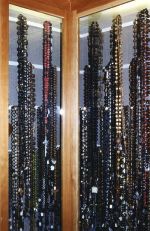 |
-------------------------------------
#2840 - OLD TESTAMENT This rosary was made by Mr. Brown commemorating the Old Testament. The 5 decades symbolize the first 5 books of the Bible, (Pentateuch). Each set of 10 beads represent the 10 Commandments, the 7 dividing beads honor the first 6 days of creation + the 7th, the day of Sabbath on which Jehovah rested. He has also included symbols of the Tabernacle, the Holy of Holies (Ark of the Covenant), the Menorah (Seven branched candlestick), the Table of Shewbread, the pole cross mounted withthe serpent of Moses, and the Star of David inlaid with abalone shell. ------------------------------------- #2870 - INERT GASSES GLOW IN THE DARK A very interesting rosary made of faceted black jet beads with large hollow double capped pyrex glass dividers. A secret mixture of inert gasses and mercury, when moved in a dark room, creates a reddish glow. From the Firefly Jewelry Co., Eugene Oregon ------------------------------------- |
|
Rosaries made of pearls, red plastic roses, deer horn, semi precious stones, glass, crystal, carved figures and metal. There was one made of faceted blue Russian trade beads, faceted garnet and of cork. There is also an American flag made up of 39 red white and blue beaded rosaries which hang all in a row. It was made by a friend from white pine that grew in the Black Hills of South Dakota. |
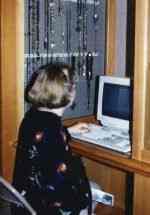 |
AN OVERWHELMING
SENSE
OF COLLECTIVE PRAYER . . . If one were to sense an energy or power from walking through thesebeads, it would have to be from the collective prayers that were ‘said', ‘prayed', ‘counted' or ‘told' on their surface over the past 67 years. One cannot deny the life and hope that has gone into them. And one cannot deny the bridges between heaven and earth that were built with these beads over the centuries.
Lenice takes advantage of the information available to search out the 4000 + rosaries and prayer beads exhibited in the center. . . . |
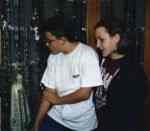
|
VARIATIONS IN DESIGN
If anything were to release us from the fear of making a rosary that might not be ‘under the rule of rosary making', this would be the place. This is the place where you see that people made rosaries with whatever was available. Some were regional, others represent what was available at the time. In the field of art and craft, some of the most wonderful developments in design come from availability and necessity. Using what you have and using it well, creates a free spirited work we often call ‘folk art'. This should be treasured. Today we go out and buy supplies and make up kits. They have their purpose but the inventiveness developed with the unexpected speaks to our hearts. The signs of resourcefulness are throughout this collection. There were elegantly chained souvenirs from holy places for the pilgrims and some were humbler, simply strung beads in the right count of the prayers to be said. In the collection we saw a filigree wedding rosary in pearls, crystal and gold which had two circlets of beads that hung from one pendant. Each circle was large enough to go around one of the partners.
Left - Wayne and Kristen Blair of Richland Washington admiring the collection while their mom, Lenice looks up information on the computer about various rosaries. |
|
Seeds: eucalyptus, 2in branches cut to form beads with bark still attached, Olive Pits, Chestnuts, Acorns, Peach Pits, Paw-Paw Seeds, Date Seeds (#143) was made from trees growing near California Missions), Trapa Seeds and Spina Christi Beans to name a few. Jobe's tears were in abundance ranging in dark to almost white in color. They came in all sizes. Many were carved, were in dark browns and blacks and hung together to create a very powerful image. |
|
TASSELS, CROSSES, BELLS This was surprising to us. Some of the rosaries were made up of small skulls called ‘death heads' (made by nuns) and had a larger skull hanging from the pendant. (It reminded us of the ‘Days of the Dead celebrations in Latin America). There was a crown, a Gamma cross (similar to a swastika), Reliquary boxes, one of which had a rose petal from Padre Pio's last Mass and one had a relic of St. Theresa. A variety of medals, tassels, crosses made from beads, knots, deer horn and one we all liked, bells. Then there was the cross made with bullets. |
|
Rosaries range in size from SMALL (small enough to fit into a thimble), to LARGE (can be one that is 16 feet, 3in long.) There are rosary gardens (ROSARIES) that are laid out in the shape of a rosary and a school in VA has painted one on their tarmac for the children to pray. |
|
Tradition tells us rosaries should never be worn as ornament or 'jewelry'. Yet carrying a rosary on one's person has a way of reminding us to pray. And people do wear them. History also points out that rosaries were often used as a 'good luck charm' of sorts. As protection? Interesting as in a way - when one believes We must not forget the rosary is a sacramental, it counts the prayers we pray. And the prayers point to the life of Christ as told by his mother, Mary. Over the centuries, these names below have become traditional and do point to the body. The center has divided them into 6 categories which we have added to for further clarification:
So
it seems, if we wear a rosary or chaplet in 'good faith',
AGES . . .
|
|
ABOUT COLUMBIA GORGE INTERPRETIVE CENTER |
|
|
|
The rosary collection is an open collection. Sharon explained they were still receiving rosaries from people all over the world. This was a request made by Don Brown himself. For more information on this collection or on the Center, please write: Don Brown Rosary
Collection
Return to:
|
|
MISSION STATEMENT Our vision is to provide the finest handmade rosaries, chaplets and other fine religious art forms for personal worship we can make using the finest supplies available. The Guild believes the work of our hands should give visual Glory to God, therefore for us, the best for you is very, very important. +++
MUSEUM
- HISTORY
- PRAYER
OFFICE
HOURS
|
|
secure-online - credit card -[or]- mail in - M.O. or personal check |